Do you like OLED TVs, but are not quite sure what benefits they bring? We will help you learn about these great panels by comparing two excellent OLED TVs. In this article, we compare two LG OLED TVs — LG B1 vs C1.
LG OLED-B1 vs lG oLED-c1 quick comparison
LG is one of the world’s largest TV manufacturers — known for producing both OLED and LED TVs. LG B1 and C1 are both OLED TVs manufactured in 2021. As such, they have a lot of similarities.
But they differ when it comes to some aspects. The largest difference is the image processor they use since the C1 uses an improved version of the Alpha processor.
| Features | LG B1 | LG C1 |
|---|---|---|
| Screen Sizes (inches) | 55, 65, and 77 inches | 48, 55, 65, 77, and 83 inches |
| Screen Panel | OLED | OLED |
| Processor | α7 Gen4 Processor 4K | α9 Gen 4 AI Processor 4K |
| Operating System | webOS 6.1 | webOS 6.0 |
| Refresh Rate | 120 Hz | 120 Hz |
| Variable Refresh Rate | Yes | Yes |
| Resolution | 4K | 4K |
| Contrast Ratio | Inf: 1 | Inf: 1 |
| HDMI Ports | 4 | 4 |
| USB Ports | 3 | 3 |
| Wi-Fi and Bluetooth | Yes | Yes |
| Speakers | 40 Watts (2.2 Channels) | 40 Watts (2.2 Channels) |
| Price | Check Price on Amazon | Check Price on Amazon |
LG B1
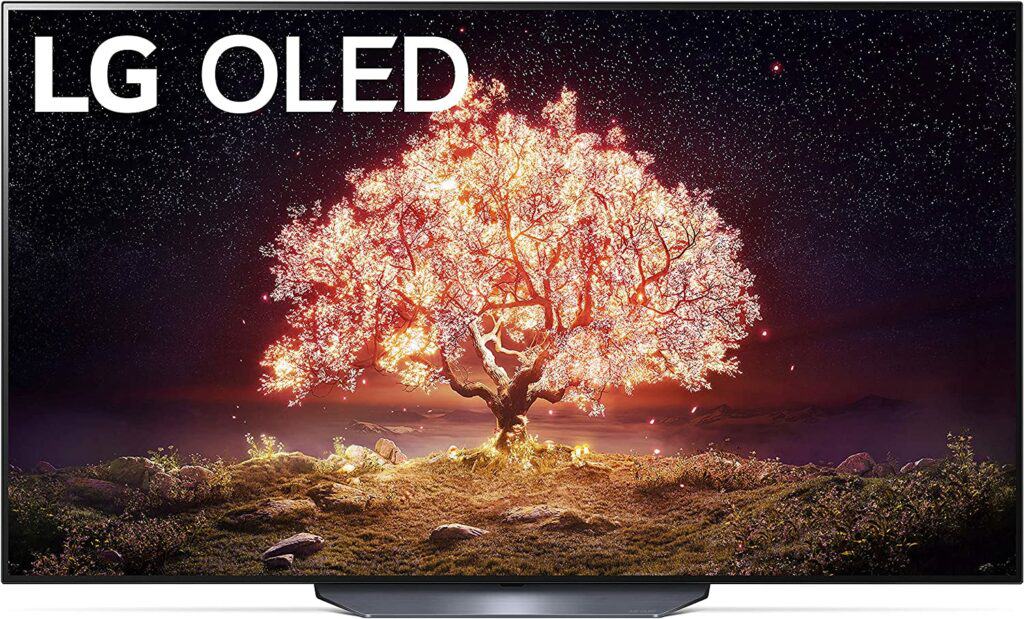
Pros:
- Color accuracy
- Smooth operating system
- Near-infinite contrast ratio
- Wide viewing angles
Cons:
- Only two HDMI 2.1 ports
- Brightness levels
LG C1
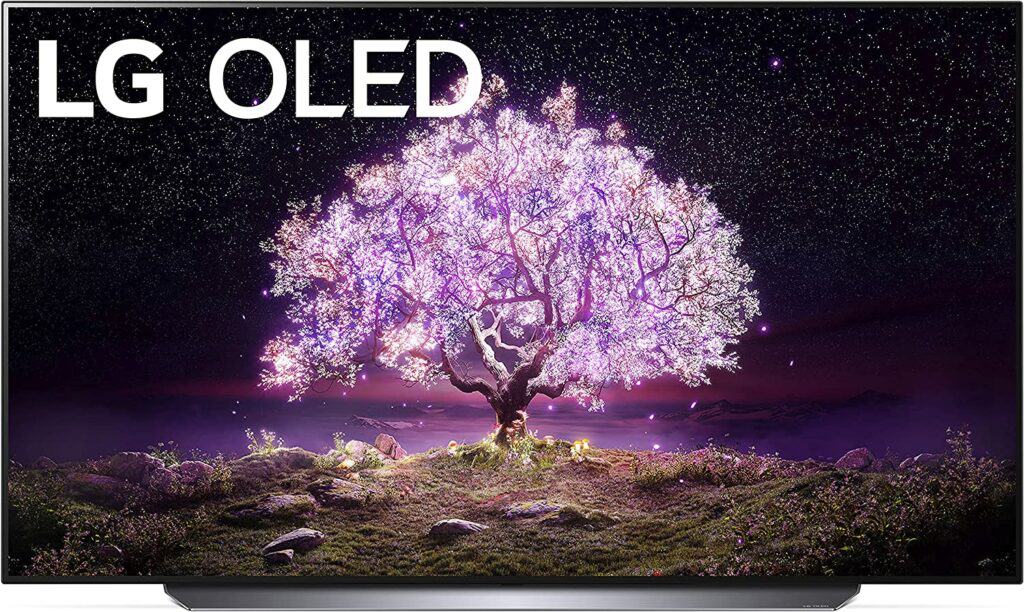
Pros:
- Fast image processor
- Better brightness levels comparatively
- Response rate
- Plenty of HDMI 2.1 ports
Cons:
- Bad pre-calibration accuracy
- No USB 3.0 ports
Features Face to Face
Panel Technology
The LG B1 and C1 have the same panel technology — OLED panels. Like any other panel type, these panels have pros and cons.
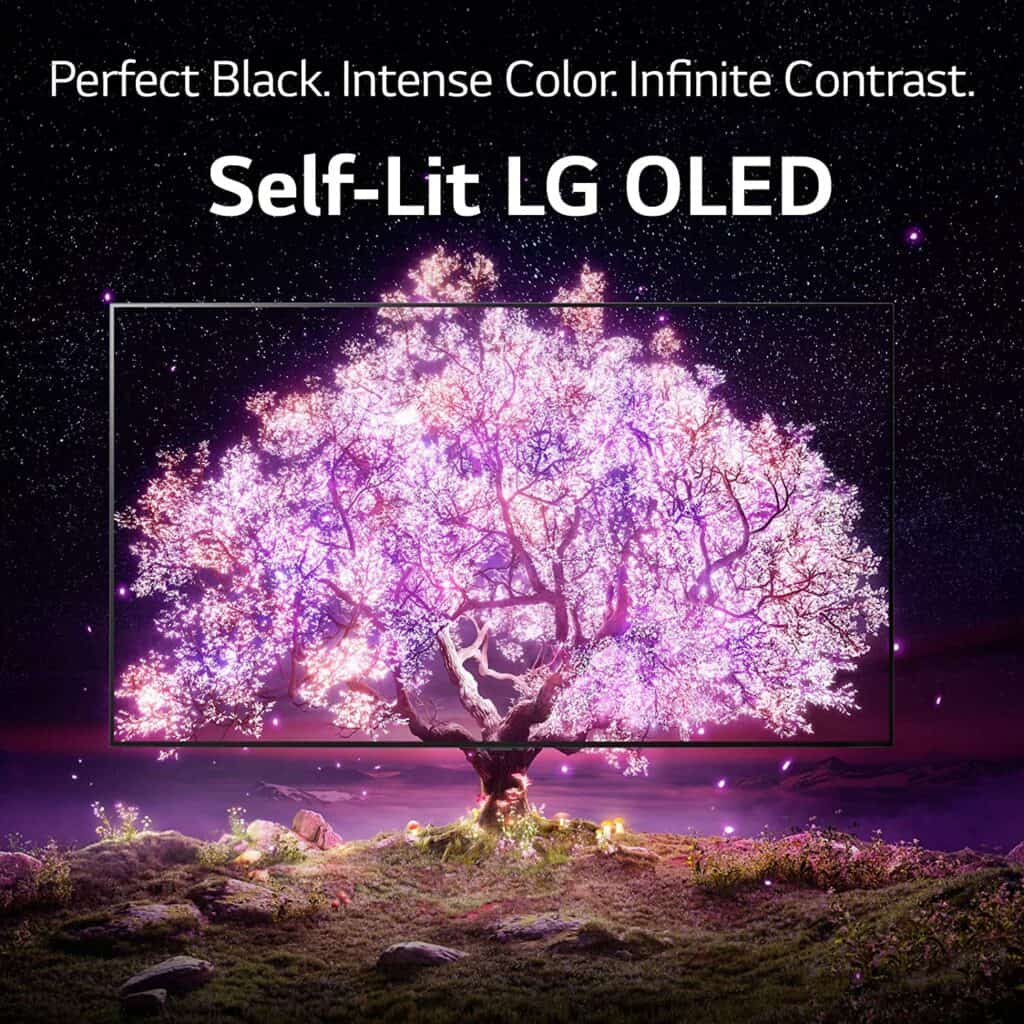
They excel when it comes to contrast and black levels. However, their brightness levels can struggle in bright rooms. Usually, they have a low response time which is crucial for the gaming experience. In general, TVs with OLED panels tend to be a bit pricey.
Winner: Draw
Image Processor
The main component that provides high picture quality is the TV’s processor. Surprisingly, these two TV models come with different processors. The LG B1 comes with the α7 Gen4 Processor 4K, while the LG C1 comes with the α9 Gen 4 AI Processor 4K.
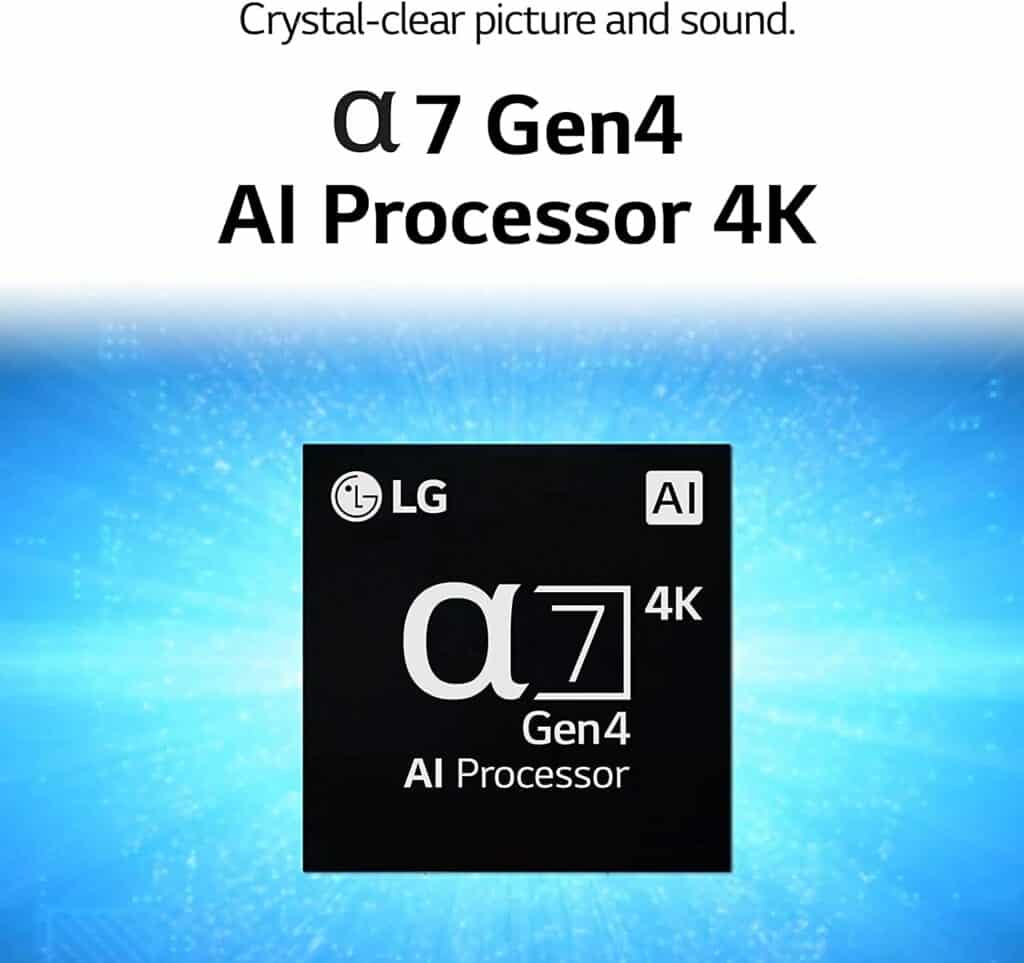
Both of these processors provide rich and natural colors, great sharpness, and fast-moving scenes without blurring.

The difference comes down to noise reduction. While the α7 uses Dual Step Noise Reduction, the α9 has Quad Step Noise Reduction. So it has smoother gradation between the colors.
Winner: LG C1
Motion Technology
Watching sports or playing video games is not enjoyable on every TV. If the TV does not have good motion handling, it could ruin your experience. Fast-moving scenes can have significant blurring if there isn’t good motion handling.
| Performance features | LG B1 | LG C1 |
|---|---|---|
| Refresh rate | 120 Hz | 120 Hz |
| Variable refresh rate | Yes | Yes |
| Response time | 3.1 ms | 2.3 ms |
| Input lag 1080p at 120 Hz | 5.0 ms | 5.2 ms |
| Input lag 4K at 120 Hz | 5.2 ms | 5.6 ms |
| Input lag 1440p at 120 Hz | 5.0 ms | 5.3 ms |
The LG B1 and C1 have great motion handling and are great in all aspects of this segment. First of all, they have 120 Hz refresh rates and support variable refresh rates (VRR). They have fantastic response times of 3.1 ms and 2.3 ms. They also have very low input lag, making them a perfect choice for gaming.
However, since the C1 has a slightly better response time, we’ll declare it the winner in this segment.
Winner: LG C1
Picture Quality
One of the most important aspects of picture quality is the TV’s resolution. The LG B1 and C1 both support 4K resolution at 120 Hz.
Contrast Ratio / Black Level
Black levels on these two TV models are fantastic. Thanks to the OLED panel, the LG B1 and C1 are both perfect 10s when it comes to native contrast.
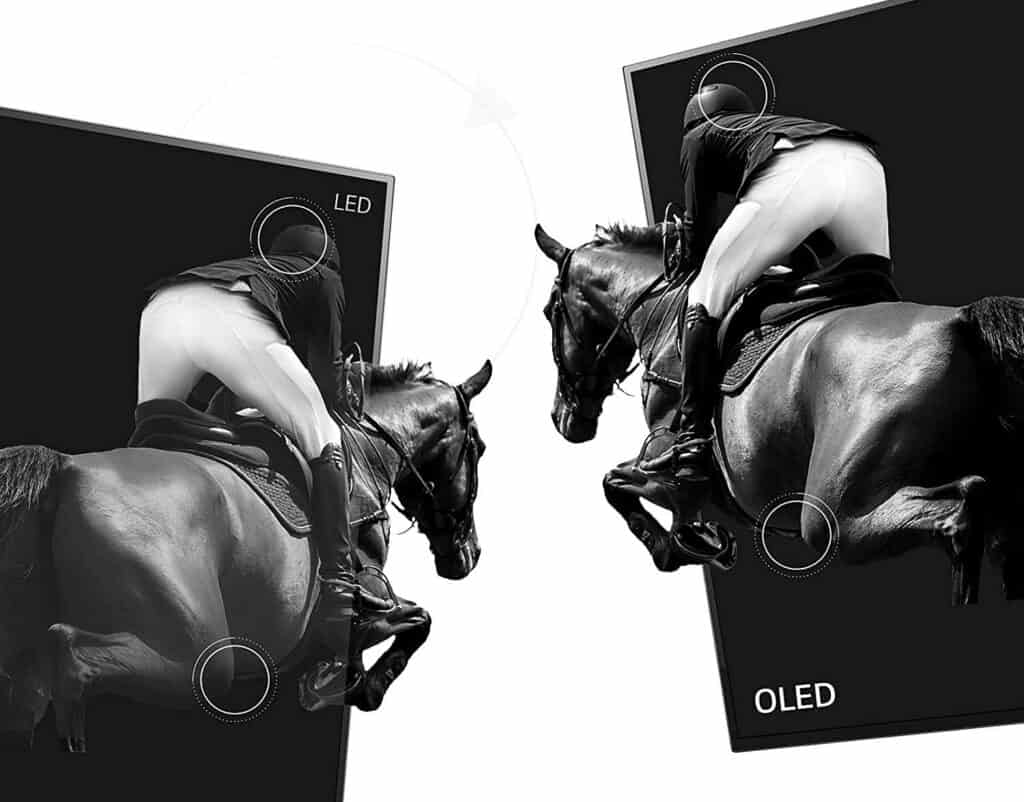
The OLED panel consists of pixels that can turn on and off individually, so both TV models have a near-infinite native contrast ratio. These self-lit pixels allow the TV to become perfectly black when displaying dark scenes.
Winner: Draw
Local Dimming
The local dimming feature is unnecessary on TVs that have a good native contrast ratio. There is no need to improve the contrast ratio on the LG B1 and C1 because they have a near-infinite contrast ratio. For that reason, neither of them come with the local dimming feature.
Winner: Draw
Peak Brightness
The peak brightness differs between these two models. The LG B1 has a maximum brightness of 600 Nits, and the LG C1 has a maximum brightness of 760 Nits. Let’s see how they compare when it comes to SDR and HDR brightness.
We can’t really say that these models excel when it comes to brightness, which is not that uncommon for OLED panels. Even though the C1 model is brighter than the B1 model, they don’t differ much when it comes to SDR brightness. Both offer decent SDR brightness. And they both struggle with large bright areas because of the Automatic Brightness Limiter (ABL).
Their HDR brightness is also okay, but the highlights don’t stand out that well. However, the LG C1 nudges ahead slightly because it has a faster processor.
Winner: LG C1
Color
The LG B1 has good pre-calibration accuracy. But you might experience slight inaccuracy when it comes to white balance. Also, you may encounter a blue tint. The C1 model has bad pre-calibration accuracy. It has the same issues as the B1 model, but they are more enhanced.
The situation changes after calibration. Both have fantastic color accuracy after calibration. White balance and color temperature are great on each model.
They have a wide color gamut and their color volume is okay. Each of them displays darker colors perfectly but can struggle with brighter colors because of the brightness levels.
Even though they are similar in almost all aspects of color display, they differ when it comes to gradient handling. The LG B1 excels in this category but has some barely noticeable banding in dark grey and green. The C1 model has good gradient handling but is not as good as the B1 model. And it has some banding in grays and greens, as well.
Winner: LG B1
Viewing Angle
Narrow viewing angles mean that the TV loses color accuracy at a certain angle. In general, the best accuracy is when sitting at the center, right in front of the TV. And when you move to each side, the color starts to shift.
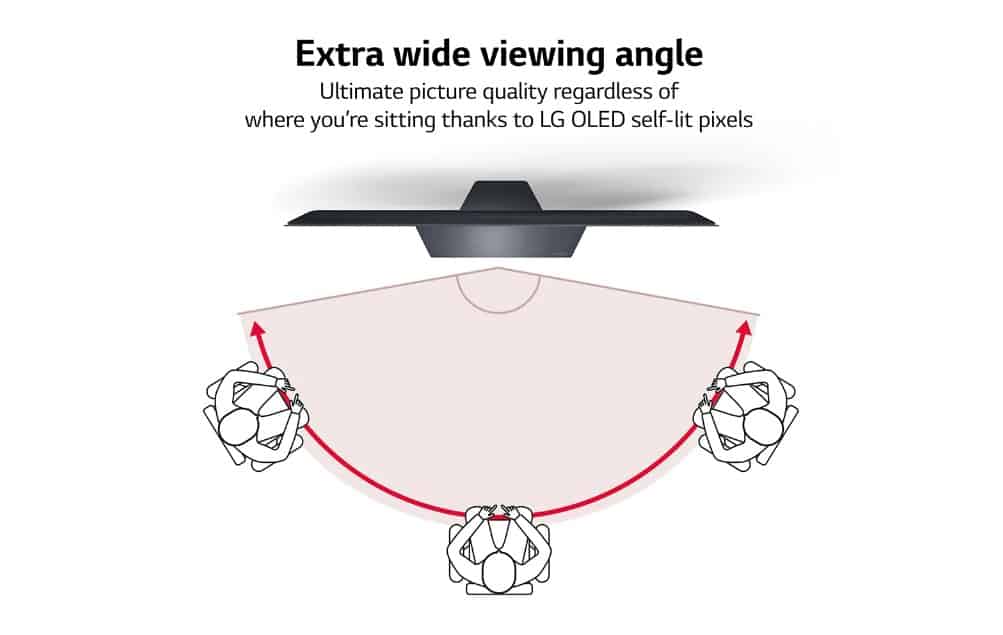
However, viewing angles are not the same on all TVs. Some have narrow and some have wider viewing angles. Let’s see when colors start to change on these two TVs.
| Viewing angle | LG B1 | LG C1 |
|---|---|---|
| Color washout | 54 deg. | 57 deg. |
| Color shift | 32 deg. | 30 deg. |
| Brightness loss | 69 deg. | 69 deg. |
| Black level raise | 70 deg. | 70 deg. |
| Gamma shift | 70 deg. | 64 deg. |
Luckily, both TVs in our LG B1 vs C1 comparison have fantastic viewing angles. But they both have a slight color shift around the 30-degree mark.
Winner: Draw
Reflections / Anti-Glare
Primarily, these two TV models are an excellent choice for dark rooms. But they perform well in bright rooms, as well.
The LG B1 and C1 have screens with a glossy finish and they are great at reflection handling. They have some reflections when placed opposite the direct light.
Winner: Draw
Sound Quality
With 40 Watts speakers via 2.2 channels, both TV models in our comparison provide decent sound quality. They have relatively loud sounds, and the dialogues are clear. But, just like most flat TVs, they lack bass.
If you want to have a more cinematic surround system, you would need to get a soundbar and a subwoofer. You can connect your soundbar via an HDMI cable or via Bluetooth. The good news is that both of these TVs support eARC.
Winner: Draw
Smart TV Platform (Operating System)
As expected, since these are two similar LG TV models, they come with the same operating system — webOS. But the LG C1 comes with a 6.0 version, whereas the LG B1 model comes with a 6.1 version.
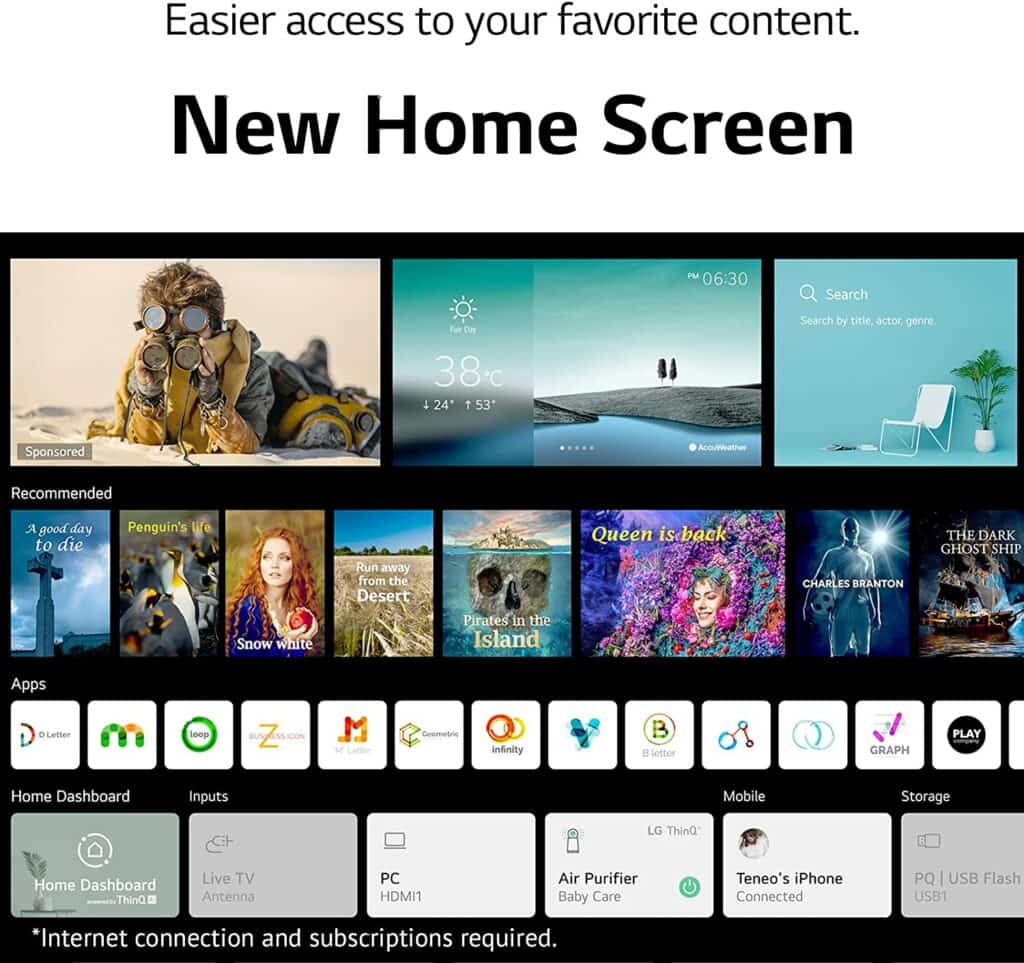
The operating system is easy to use and has smooth navigation. You have a large selection of apps, but the downside is that they contain ads.
Winner: LG B1
Connectivity
Inputs
Since the resolution is higher and higher on today’s TVs, HDMI 2.0 is slowly pushed out of the picture. HDMI 2.1 is becoming more and more dominant since it can support 8K resolution and up to 120 fps.
A lot of TVs today support HDMI 2.1, and some of them have all of their HDMI ports supporting HDMI 2.1. This is not the case with the LG B1 since only two ports support HDMI 2.1. The good news is that the LG C1 has all four HDMI ports supporting HDMI 2.1.
| Inputs | LG B1 | LG C1 |
|---|---|---|
| HDMI ports | 4 | 4 |
| USB ports | 3 | 3 |
| Ethernet | Yes | Yes |
| Digital audio output | Yes | Yes |
| 3.5 mm jack | Yes | Yes |
Neither of these TVs supports USB 3.0, but they support USB 2.0, and each has three of these ports. Each of them also has an ethernet port, digital audio output, and a 3.5 mm jack.
Since the C1 model has more ports that support HDMI 2.1, it prevails in this category.
Winner: LG C1
Voice Assistants
There is no difference between these two models when it comes to voice assistants. Each of them comes with integrated Google Assistant and Amazon Alexa.
Winner: Draw
Wireless Technologies
The LG B1 and C1 both support Wi-Fi, 2.4 GHz and 5 GHz. They also support Bluetooth connectivity, version 5.0.
Having a Bluetooth connection on your TV brings many benefits. You can connect speakers or headsets, your smartphone, a keyboard, and other wireless devices. You don’t need any cables at all.
Winner: Draw
Standout Features
The LG B1 and C1 both come with a stand. But if you want to, you have the option of placing them on a beautiful tripod stand and making them look more sophisticated.

These TV models are among the few TVs that can be installed on the LG Gallery Stand. The downside is that this stand is sold separately.
Conclusion
Let’s see a brief overview of this LG B1 vs C1 comparison.
The LG B1 has great color accuracy, great reflection handling, and a fantastic contrast ratio. So, it is a pleasure to watch TV in dark surroundings. If you have wide seating areas, this TV is a great choice since it has wide viewing angles.
The LG C1 has a 120 Hz refresh rate, VRR support, plenty of HDMI 2.1 ports, a good response rate, low input lag, and an improved Alpha processor. So, it’s a good choice for watching sports and action movies or playing video games.